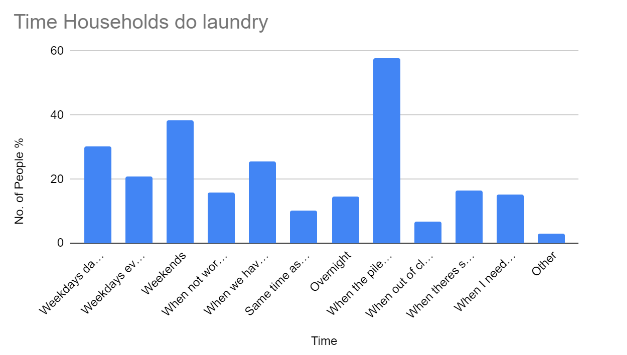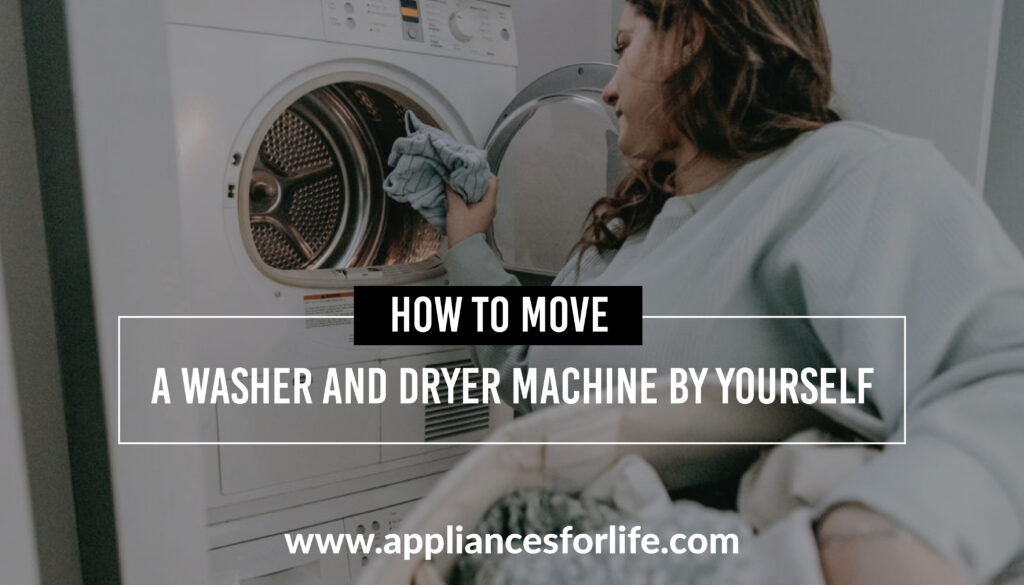- Lifting a washing machine is as easy as a sunday morning. As long as you know what to do.
- The average washing machine weighs between 150 pounds (68kgs) and 200 pounds (90kgs).
- The time for moving your washer and dryer has come.
- Moving a washer and dryer is heavy-duty work and involves following specific safeguards making the process much more complicated than moving your TV, for instance
Under normal circumstances, a washing machine is an appliance that is rooted in one spot, be it the kitchen, garage, or specialized laundry room.
Lifting a washing machine is as easy as a sunday morning. As long as you know what to do. Make sure you have someone else to help you do it because the shape and size of the appliance make it unwieldy for one person. Still wondering how to lift a washing machine? Follow these simple four steps to lift your washing machine:
- Tilt the washing machine.
- Lift the wshing machine
- If you are moving it to a different location, then carry the washing machine up or down the stairs.
- Put the machine down.
The average washing machine weighs between 150 pounds (68kgs) and 200 pounds (90kgs). That is heavy by any standards. Washing machines are also big. The average front-loading device has a height of about 33.46 inches (850 mm) and a width of approximately 23.62 inches (600 mm). Here’s what you will need:
Workforce: Because of the size and shape, you’ll need an extra pair of hands regarding how to lift a washing machine. The advisory I will roll out for you is that you hire experienced movers to do the lifting for you. Because they are used to the task, it will be faster and safer than you could do it. But, if you are the hulk or an avid DIYer or just want to save that extra buck in moving costs, you might consider doing it yourself. You will still need that extra pair of hands, though. Consider friends and family as the first option when looking for that extra hand since they are unlikely to charge you for their help.
Instruction Manual: Now is the time to pull out the machine’s user manual. If you misplaced your user manual or cannot find it, do a Google search of your washing machine brand, its model, and the word “manual” at the end. It is important to review the manufacturer’s recommendations on how and when to move your appliance.
How to unhook a washing machine:
The time for moving your washer and dryer has come. Under normal circumstances, a washing machine is an appliance rooted in one spot, be it the kitchen, garage, or specialized laundry room. No doubt there will be a time when you will need to move it from its usual perch for reasons varying from moving house to renovations. When this time comes, it is helpful that you prepare your washer and dryer for moving and you know what to do with the wires and hoses that give power and water to your appliance. Here’s the lowdown on how to unhook a washing machine:
- Disconnect the washer and dryer: Pull the plug to ensure your machine is switched off, and no power is supplied. Once the power is off, we are sure the device is completely switched off, and we do not have to worry about any surprises as far as electricity supply is concerned.
- Turn off the water: The cold and hot water supply usually comes into the washing machine through the back. Turn off the valve by twisting the valve clockwise until the end. The valve when off will turn off the water supply to the washing machine. It will also protect you from water spills should you accidentally tear a hose. For washing machines that heat the water inside the unit, you will only have to deal with one pipe, the cold water.
- Push: Move the appliance away from the wall. If you are working alone, push or pull one side at a time. If you have a helping hand, you can simultaneously move both sides of the machine. Your objective should be to push it as far away from the wall so that there is enough room for you to step behind the machine. Depending on the design of your house, you may be able to access the water box without needing to move the washing machine.
- Bucket: The loosened hoses are holding water inside. To prevent the spillage, place a bucket behind the washing machine and underneath the water lines so that it catches water when the pipes are detached.
- Unfasten the pipes from the machine: Cross-check that your valves are still off. You might have inadvertently turned the water back on as you were moving the machine. Unscrew the water hoses from the back. The unscrewing is usually a counterclockwise movement until the clamps loosen and the hose comes off. When the hoses are free, the timeto use the bucket comes in. Point the pipes into the bucket for any leftover water to drain.
- Unfasten the hoses from the wall: This is usually a counterclockwise motion. Unscrew the hoses from the wall end until they are completely detached. If the machine has not been moved in a long while, this will be a tough task, so you may need to bring in some tools, preferably a pipe wrench or adjustable pliers. Once the pipes are out, empty them of any water into the bucket and pack them well, maybe in a large plastic bag.
- 7. Disconnect the drain hose: Drainage hoses are permanently connected to the washing machine, so you can only disconnect them from the drainage end. Though drainage setups will differ depending on plumbing design and washing machine model, how to disconnect the drain should be pretty straightforward. If that disconnection is not obvious, you must consult your user manual. The drain pipe is usually held by a special bracket. Use tape to secure it to the device so it is safely out of the way when you begin moving.
Moving washer and dryer:
Moving a washer and dryer is heavy-duty work and involves following specific safeguards making the process much more complicated than moving your TV, for instance. Washers and dryers require their drums to be secured during pre-moving preparations, or they will be damaged. We recommend you consider bringing in expert hands of washer and dryer movers to help you to relocate the washer and dryer.
How to move a washer and dryer by yourself:
This is a task that requires adequate advance preparation, especially when you are doing it by yourself. Whether it is a front loader or top loader, it is necessary to have the right tools, supplies, assistance and adequate planning as you prepare the washer and dryer for moving. The following are what needs to be done to prepare your washer and dryer for moving:
Locate the owner’s manual and product warranty: For starters, it is important to have all the machine’s manual and warranties at the ready when moving. Read the manual on the parts that give instructions on disconnecting and connecting your washer and dryer. The manual will also carry instructions on how to move the appliances. The washer and dryer warranty details will be handy in the event that anything goes wrong during the moving exercise and you are faced with equipment damage. Ensure you put these crucial documents in a safe andsecure place where you can easily find them.
Get the right moving equipment: The equipment you assemble is what will make the difference in your task especially when it comes to determining whether you get this right or wrong. You will need gloves, appliance dolly, moving straps, moving blankets, a vacuum cleaner, wrench, pliers, washing machine cleaners and packing tape.
Assemble your team: Get together your team of extra hands and helpers. It is important to understand that when it comes to how to lift a dryer by yourself does not mean doing so singlehandedly, rather, “by yourself” refers to doing the job without hiring professional help. We advice getting one or two other people to help out from your pool of relatives, friends and neighbors. It is safe to vet the help you bring on board by ensuring they are physically fit enough to do some heavy lifting and are wearing appropriate clothing and gear, including closed toe shoes.
Reconnaissance: In order for you to be sure the washer and dryer will fit through your doorways and your staircase, it is important to measure these in advance. Inspect and confirm the pathway you will use to move the appliances to ensure there are no obstacles or obstructions along the way.
Clean: Clean both appliances before the date and time of moving them. Cleaning is a crucial part of machine maintenance as it will not only improve efficiency but also prevent bad smells. Use a formula or tablet specifically formulated to clean and sanitize your washing machine. Run the washing machine after you have put in the tablet and once the cycle is complete, leave the washer door open for at least a day to dry and freshen up the inside. Cleaning the dryer involves emptying the lint trap and cleaning it with a brush or vacuum.

The graph above shows the prefered times for households to do their laundry. research.manchester.ac.uk
Moving a washer and dryer:
- First, we ensure safety by powering down the washer and dryer. Switch off the electric supply to the washer and dryer from the socket and unplug it from the wall. Secure the electrical cords if possible to the appliance using tape. You want them in one place during the moving process and not swinging around freely.
- Close the water supply to the washer. This is done by turning off the valves behind the washer. Once they are off, remove the cold and hot water hoses from the wall and drain them.
- If your dryer is gas powered, it is necessary to shut off the gas valve on the dryer and disconnect the gas line. This part of the job is best handled by a professional. The rule of thumb is if at any point you’re not sure about what you should be doing, then dont do it. Call a professional.
- Move the dryer away from the wall and disconnect the vents.
- Clean your dryers vents with a vacuum cleaner extension.
- Secure the drum. Depending on the model, the drum is normally held in place during transportation with either shipping bolts, a Y-shaped piece of foam or tightening some screws in the back. Consult your manual for the brand specific way the drum is secured for shipping.
- Pad the washer and dryer for protection with the use of moving blankets. This will insulate them against dents and scratches. Hold the moving blanket in place by using packing tape. Avoid plastic sheeting or tarps as that will catalyze humidity.
- The best way to move a washer and dryer is therefore as follows: with the help of your team, gentle move your washer and dryer to the dolly. Amazon.com. If you have stairs to deal with you can opt to use forearm forklifts. For additional safety, use an appliance forearm forklifts or an appliance dolly to move the washer and dryer. Tip the machine backwards and slide it into the dolly and secure it with moving straps or rope.
- If your staircase is mostly straight, a dolly is the best way to move the washer and dryer downstairs, it will come in handy as it has extra tracks that allow for dragging or lowering the the appliance across multiple steps simultaneously. With one person behind the dolly holding the machine in place and someone else gentle rolling the dolly, roll it through the house and out the door.
- Load the washer onto the moving truck via the loading ramp while ensuring the washing machine is in an upright position and secured with tiedowns during transit.
How to move a washer and dryer without a dolly:
To move a washer and dryer without a dolly safely requires the use of a moving harness. Also known as furniture lifting straps, they use the leverage principle to allow you handle above normal weight. Check here for one amazon.com. The moving straps help you and your partner to easily lift and move the weight of a washer and dryer or any other heavy furniture that you would normally be unable to lift. The harness wraps around your body, is then slipped under the object you are carrying distributing its weight equally between you and your moving partner and lowering the object’s center of gravity. The are two basic designs, the shoulder and the forearm forklift. It is estimated that a moving harness will make lifting that heaver washer and dryer feel 66% lighter. Not to mention that the harness will make navigating those stairs a breeze. The Moving Harness comes with the following advantages:
- Lightens your load by 66%
- Ensures that your lifting technique is correct
- Uses additional leverage when lifting
- Prevents and reduces injuries especially of the back because the require less bending and twisting to get the job done.
- The harness will protect your floor from scratches and damage that dragging items causes.
- Enables you carry loads of up to 700 lbs
- They are easy to use and affordable
Shoulder or forearm moving straps require the same basic guidelines for use:
- The straps come with basic guidelines. Make time to read them and to understand what you need to do, how to fit the straps and the proper lifting technique. Brief your moving partner on the how-to.
- Dress in the appropriate gear for moving giving a bias to strong shoes with grip and comfortable clothing.
- Decide on the best route to use when moving the items and survey it for any possible obstructions or difficult points that need extra attention. Pay special attention to doorways and staircases to make sure the machine will pass through. Rehearse any challenging parts of the course with your partner before you do the actual lifting.
- Wear your straps on the shoulders or forearm depending on the type of harness you are using. Refer to the instruction manual and adjust the straps accordingly to avoid slippage.
- Put the strap on the floor in front of the washer and dryer and with your partner’s help, tip the appliance back and slide the strap underneath. Repeat the process if your harness has two straps. Then proceed to center the strap if your harness has one strap. If it is two-strapped, place each strap near the front and back ends of your appliance so that it is centered.
- You can now proceed to lift the appliance using the appropriate lifting technique for shoulder or forearm harness. Work in unison with your partner, lifting and moving at the same time. One person will have to take steps forward and the other will have to take steps backwards. Communicate clearly as you move to ensure you take breaks and make adjustments with the other party well aware of what is coming next.
- When you reach your destination lower the washer and dryer in unison with your moving partner. Then proceed to remove the harness from yourselves.
Transporting washer and dryer in truck:
A truck will be a viable option when it comes to how to transport a washer and dryer. Are you going via the highway? Is the trip hilly? After factoring in the distance and complexity of your move, the next thing you need to think about is the placement of your washer and dryer in the transportation truck. For stability and to minimize shifting, it is best to load the washer and dryer closest to the cab. Consider investing in ratchet tie-downs, moreso if you are using a pick-up truck instead of a moving truck, as they will help hold your items tight and in place during the moving.
Frequently Asked Questions:
Q: Why is the dryer always on top of the washer with a stackable washing machine?
A: This is to prevent water running into the dryer in the event that there is a leakage or problem with the washer. If the washer was to malfunction and flood, the dryer would be damaged too and possibly start a fire. Plus because the washer handles water, it is much heavier than the dryer which is lightweight in comparison. Putting the washer up is therefore unnecessarily straining the dryer.
Q: Are washers and dryers 240V?
A: Most driers run on 240 Volts, domestic washing machines on the other hand typically use 120 Volts.
Q: Why dont they make 2-in-1 washers and dryers?
They do. Most major brands manufacture a washer and dryer. Mostly available as front loaders, with the wsh cycle similar to any other front loading washing machine. The dry cycle however, operates as a “condenser dryer”.
Conclusion:
Consider hiring a professional mover if all the lifting and technical aspects we have covered here today are too much for you. They will do the heavy lifting for you and take all the mental acrobatics you might have gone through out of the way.
22 MINUTES
ESTIMATED TIME DESIGNING AND UPLOADING THIS ARTICLE
10 HOURS 45 MINUTES
ESTIMATED TIME RESEARCHING AND WRITING THIS ARTICLE
You Might Also Like

Top 3 Best LED Light Bulbs for Refrigerators
Refrigerator lights, or refrigerator bulbs as some would often call them – are extremely important to have as replacements just in case the ones that come with the refrigerator go out. This article will be looking at the best LED light bulbs for refrigerators.

A Guide To Kohler Kitchen Faucet Parts
As an Amazon Associate we earn from qualifying purchases. We may earn a small commission for our endorsement, recommendation, testimonial and/or link to any products or services from this website. Thank you, your qualifying purchases help support our work in bringing you real daily gift

Hummus is commonly made with a food processor or blender but in this article, we’re going to be taking you through how to make hummus by hand, without a blender or food processor. There are different hummus recipes you can try without a food processor

Wine Cellar Cooling Unit Reviews: The Best of The Best
What are wine cellar cooling units? This question also answers why most wine cellars need cooling units. A wine cellar cooling unit is an appliance that regulates temperature and humidity levels within a wine cellar for the sole purpose of providing perfect conditions for wine

The best way to ensure your air conditioning units last longer is to ensure they are properly maintained and one of the best ways to do this is to get them covered. We’ll be taking you through some of the benefits of having covers for

How to Clean a Front Loader Washing Machine?
Front-load washing machines have superior cleaning experience to their top-load counterparts. Not only do front-loaders clean better, but they are also extremely energy efficient. To a very large extent, they give you a cut on your utility bills. However, it is necessary to regularly maintain

Best Blenders for Grinding Rice
You can’t talk about the most popular kitchen appliances without mentioning blenders – that’s how important they’ve become. In this article, we’ll be reviewing the best blenders for grinding rice. Best Blenders for Grinding Rice Comparison Table Blenders are the most underappreciated kitchen appliances because,

Good Fruits and Vegetables to Juice – Plus Recipes
Juicing has become a top trend and today you can get freshly squeezed juice anywhere you go. It is convenient to be able to make juice at home for the whole family, it is healthy, tasty and so much more economical than store bought juice.

Top 5 Most Amazing 48-inch Ductless Range Hoods
In our 48” ductless range hood review, we’ll be exploring the best 48-inch ductless range hoods available on the market today. Top 5 48-inch Ductless Range Hood Comparison Table As impressive as cooking it, you can’t afford to do it in an unsafe environment

How To Use Electrolux Washer and Dryer
For many years, Electrolux has forced its way to the summit of the best appliance brands in the world. For the first time, Electrolux has broken the trend and created a shift in power from the likes of LG and Samsung. Is Electrolux a good

